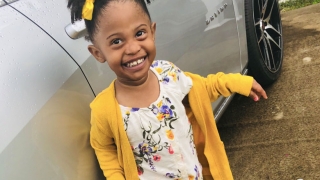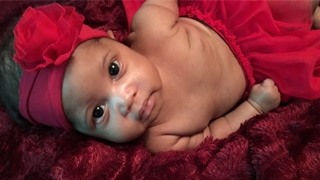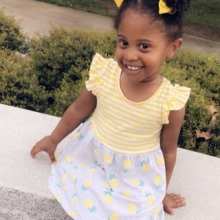Sacrococcygeal Teratoma (SCT): Emoni’s Story
Published on
Published on
Emoni’s journey to Children’s Hospital of Philadelphia (CHOP) began before birth, with a regularly scheduled 20-week fetal ultrasound in Macon, Georgia. The technician was going through her checklist and telling Emoni’s parents, Chiquita and Adonis, what she saw.
 “She stopped and went quiet,” Chiquita recalls. “We could see a big dark circle on the screen. I asked what it was, and she said, ‘Give me a minute. I’m going to grab the doctor.’”
“She stopped and went quiet,” Chiquita recalls. “We could see a big dark circle on the screen. I asked what it was, and she said, ‘Give me a minute. I’m going to grab the doctor.’”
After the doctor looked at the image, he told the couple that their baby had a problem. There was a growth on the lower part of her spine. He thought it was spina bifida, a birth defect in which a baby’s spinal cord fails to develop properly, and referred them to a specialist for more accurate imaging and a more qualified diagnosis.
“We both broke down,” says Chiquita. “I was hysterical.”
At that next visit, the doctor did a more thorough ultrasound, checking for movement in the lower extremities (spina bifida can cause paralysis of the lower body). The baby was moving and kicking, and the location of the growth didn’t fit with the first diagnosis.
The specialist determined that the problem was sacrococcygeal teratoma (SCT), a tumor that grows from a developing baby’s tailbone (coccyx). SCT is the most common type of tumor in newborns. It is associated with some risks, but if monitored closely those risks can be managed, and in most cases the tumor can be removed at birth with surgery. He explained all of this, and referred the couple to CHOP.
That began the family’s connection with CHOP. Initial phone calls with Jessica Hertzog, MSW, a Social Worker, and Heather Socki, RN, a Clinical Coordinator, led to their first appointment in Philadelphia, scheduled for September.
Upon arriving in Philadelphia, Chiquita and Adonis met N. Scott Adzick, MD, Surgeon-in-Chief and Founder and Director of the Richard D. Wood Jr. Center for Fetal Diagnosis and Treatment (CFDT). Dr. Adzick confirmed the diagnosis of SCT, and explained that the growth was almost entirely external and mostly cystic (filled with fluid). The SCT did not have a rich blood supply nor were there any signs of fetal heart failure called hydrops.
These were all good signs, and meant that surgery to remove the tumor after birth would most likely be a straightforward procedure. Dr. Adzick and his team have pioneered fetal surgery for large SCTs with a rich blood supply causing life-threatening heart failure in the fetus, but fetal surgery was not warranted in this case.
“It was so reassuring,” says Chiquita. “Where the appointments in Georgia had been scary and frantic, here they were calm. The people at CHOP were very good at explaining everything to us. We trusted them right away.”
Plans were made for a return visit in October to monitor the growth of the tumor and make sure no immediate intervention was needed. The family would then come back to Philadelphia in November, where they would stay through the birth and surgery, which were expected to be in late December.
For all of these trips, Hertzog and the social work team at CHOP found ways to ease the financial and emotional burden on the family and make the long stay comfortable. The CFDT offers a wide variety of counseling and support services to help with any non-medical needs that come up along the way.
One of the resources that helped the family make the trip was Addison’s Hope for Fetal Families Fund, established by the Kelly family, whose daughter Addison had lifesaving fetal surgery at the Hospital. The fund helps pay for things insurance will not, such as travel costs, lodging, and other expenses related to getting to and staying in Philadelphia.
Arrangements were made for the family to stay at the Ronald McDonald House. Southwest Airlines provided free air travel to the family, including a trip for Chiquita’s mother when she was needed in Philadelphia to care for Emoni’s big sisters — Mikalah, 6, and Marley, 1.
As the due date approached, the medical team closely monitored both Chiquita and Emoni. When scans of the baby showed that the tumor had grown too large for a safe delivery, a procedure was performed to drain fluid from the cystic mass.
Emoni was born on Dec. 22 in the Garbose Family Special Delivery Unit, the world’s first birthing unit within a pediatric hospital designed specifically for healthy mothers carrying babies with serious birth defects. Both Emoni and Chiquita had access to expert medical teams who were prepared to handle the delivery of a baby with SCT and care for both mother and baby.
The next day, Dr. Adzick performed a surgical resection to remove the tumor. Chiquita was released in time to celebrate Christmas with her husband and two older daughters at the Ronald McDonald House, while Emoni stayed at CHOP through the middle of January.
 Back in Georgia now, Emoni’s big sisters miss the fun they had and the friends they made in Philadelphia. What could have been a scary and stressful event instead created wonderful memories.
Back in Georgia now, Emoni’s big sisters miss the fun they had and the friends they made in Philadelphia. What could have been a scary and stressful event instead created wonderful memories.
“The Ronald McDonald House was our home away from home,” says Chiquita. “Mikalah and Marley loved it there. They made friends with the other kids who were staying there, and the staff had special activities for the kids every day. Marley turned 1 on December 23, and they had a special party for her. Christmas was amazing. Santa came and they had gifts for the kids.”
In addition to the wonderful services provided by the Ronald McDonald House, the Kelly Ann Dolan Memorial Fund played a large part in making Christmas so memorable by organizing gifts for the girls.
Knowing that Mikalah and Marley were happy there made it easier for Chiquita to spend her days at CHOP with Emoni. She would leave every morning at 8 a.m. and come back at 4 p.m. Either Adonis or Chiquita’s mother stayed with the two girls while she was gone.
 Today, Emoni is an extremely happy 2 year old who is full of energy and loves to learn. According to her mom, her vocabulary is expanding every day and she loves animals. "She's everyone's ray of sunshine," says Chiquita.
Today, Emoni is an extremely happy 2 year old who is full of energy and loves to learn. According to her mom, her vocabulary is expanding every day and she loves animals. "She's everyone's ray of sunshine," says Chiquita.
Emoni sees a pediatrician in Georgia who stays in close communication with the medical team at CHOP, where she returns every six months for follow-up visits which will continue until she is 3 years old.
“Choosing CHOP was the best decision we could have made, for my care as well as Emoni's care,” says Chiquita. “CHOP is full of amazing doctors and nurses. I love them all, and I am so grateful for them."
"We were referred to CHOP for a reason,” says Adonis. “I had faith everything would be OK, and with their help, it was just that."
Emoni carries that sentiment with her everywhere she goes — her name is a variation of the Swahili word for “faith,” which her parents chose for their faith in the bright future ahead of her.
Published February 2017
Updated May 2019